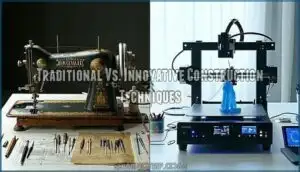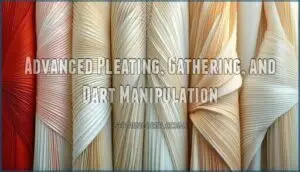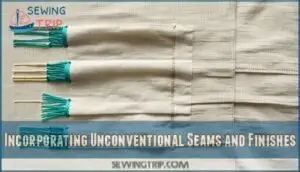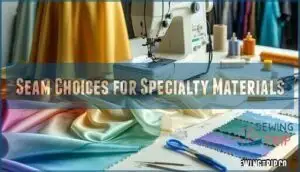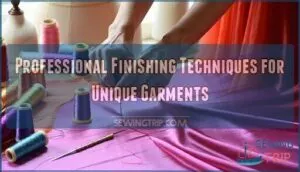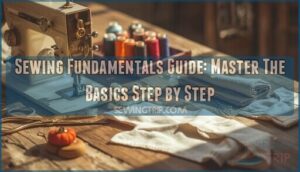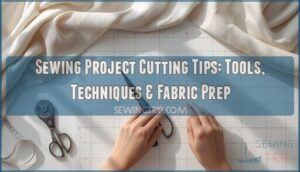This site is supported by our readers. We may earn a commission, at no cost to you, if you purchase through links.

Experimental draping shapes fabric into fluid, sculptural forms, far from cookie-cutter fashion. Creative seams and unexpected finishes build garments that don’t just look unique—they feel it, too.
If you’re ready to stitch outside the lines, these hands-on approaches can transform both your process and your closet. Ready for the nuts and bolts? There’s more beyond the hem.
Table Of Contents
- Key Takeaways
- Why Garment Construction Methods Matter
- Traditional Vs. Innovative Construction Techniques
- Step-by-Step Guide to Unique Methods
- Specialty Fabrics and Construction Challenges
- Integrating Technology in Garment Construction
- Future Trends in Garment Construction
- Frequently Asked Questions (FAQs)
- Conclusion
Key Takeaways
- Innovative construction methods like zero-waste pattern cutting and modular designs reduce fabric waste and offer greater creative freedom. – The way you build a garment directly impacts its fit, durability, and the comfort it offers. – Technology such as CAD, 3D printing, and automation is revolutionizing how clothes are designed and produced. – Choosing sustainable materials and smart construction practices helps cut environmental impact while opening new design possibilities.
Why Garment Construction Methods Matter
How a garment is put together affects everything—fit, durability, even your style options down the line. When you get to know these construction methods, it’s way easier to spot real quality, shop sustainably, and even push your own sense of design.
Impact on Garment Quality and Fit
How you put a garment together shapes everything: how it hugs the body, how long it survives wear and washing, and whether someone actually wants to reach for it again. It comes down to a handful of choices:
- If your seams are strong, your garment stays together through all kinds of movement and laundry days.
- Darts and pleats aren’t just for looks—they take fabric from flat to perfectly contoured.
- The way a fabric drapes is influenced by every technique and tweak you make as you sew.
- Pay attention to those finishing touches—construction details matter for how it feels on your skin and how polished it looks.
- If you want fit to be reliable, focus on precise pattern work and smart seam practices.
Get these down, and you’ll have control from the scissors’ first snip until that final, satisfying stitch.
Role in Sustainability and Waste Reduction
Your fabric selection and cutting process shape more than fit—they define environmental impact. Traditional garment construction wastes 15–20% of fabric, but zero-waste design eliminates that loss entirely. Modular clothing extends garment life through replaceable parts, cutting production demand.
Textile recycling and circularity principles transform waste into new materials, addressing the 92 million tonnes the industry discards yearly. The textile sector contributes considerably, accounting for 8% of global emissions.
Emissions reduction follows when you improve material usage from the start, making sustainable practices inseparable from smart construction choices.
Influence on Fashion Design and Creativity
Construction methods don’t just solve technical problems—they broaden new ways to imagine what clothing can become. Draping fabric into sculptural forms shows how textile manipulation transforms flat material into artistic expression.
Creative seaming generates unexpected silhouette innovation, while decorative techniques like experimental pleating merge sewing techniques with design inspiration.
Your construction choices directly shape fashion design possibilities, turning technical skills into garment construction that redefines limits.
Importance for Designers and Entrepreneurs
When you understand how construction methods work, you don’t just make better garments—you build a business that stands out in a crowded market. Here’s why garment construction knowledge matters:
- Design Innovation meets market viability when you know which sewing techniques deliver your vision profitably
- Cost Optimization happens through smart pattern making that reduces waste without sacrificing quality
- Brand Identity strengthens when your clothing construction techniques become your signature
- Production Growth becomes possible once you match fashion design ambitions with realistic manufacturing capabilities
- Mastering weaving, knitting, and cut-and-sew methods lets you pivot quickly when trends shift
Traditional Vs. Innovative Construction Techniques
You’ll find that garment construction splits into two camps: the tried-and-true methods that built the fashion industry, and the fresh approaches reshaping it today.
Let’s look at how traditional techniques like cut-and-sew stack up against game-changers like zero-waste cutting and modular systems.
Overview of Cut-and-sew, Knitting, and Weaving
If you’ve ever wondered why some clothes drape like a dream while others feel stiff or lose their shape after one wash, the answer lies in how they’re built from the ground up. Three foundational techniques define garment construction: cut-and-sew fitting, knitting, and weaving. Each method creates distinct fabric properties that directly affect how your finished piece looks, feels, and performs.
Method Key Characteristic Best For Fabric Suitability
Understanding fabric suitability and knitting stretchability versus weaving durability helps you choose the right construction approach for your design vision.
Zero-waste Pattern Cutting Explained
Knowing how stretchy knit fabrics feel compared to the sturdy nature of wovens makes it way easier to pick the right method for the kind of clothes you want to create.
This patternmaking method delivers waste reduction while tackling design constraints—fabric cutting becomes a puzzle where every piece fits. The market impact is real: zero-waste fashion hit $7.8 billion in 2024, proving sustainability outcomes drive both innovation and profit in garment construction. The Asia-Pacific region is expected to see the highest growth, with a 16.7% projected CAGR during the forecast period.
| Zero-Waste Benefit | Real Impact |
|---|---|
| Fabric utilization | Nearly 100% used, no scraps |
| Waste reduction | Eliminates 15–20% manufacturing loss |
| Market growth | $7.8B in 2024, $23.4B by 2033 |
| Environmental gain | Cuts water, energy, chemical demand |
| Design innovation | Geometric layouts introduce new styles |
Modular Garment Systems
Modular garments let you rearrange pieces like building blocks, turning one wardrobe into dozens of outfits without buying more clothing. Interchangeable components—sleeves, collars, panels—attach through zippers, snaps, or magnetic closures, offering adaptable design that adapts to your mood or season. This approach cuts waste dramatically: you’re not discarding entire garments, just swapping structural design elements. Patternmaking demands precision so seam types align across modules, and fabric manipulation ensures each piece works alone or together. Customization options expand as on-demand production lets you order only the components you need.
| Modular Feature | Construction Method | Your Benefit |
|---|---|---|
| Detachable sleeves | Hidden zippers, snap tape | Transform silhouettes instantly |
| Reversible panels | French seams, flat-fell seams | Two looks, one garment |
| Adjustable hems | Hook-and-loop, magnetic closures | Perfect length every time |
| Interchangeable collars | Button plackets, grosgrain loops | Style update without new purchases |
| Mix-and-match layers | Weaving, precise fabric cutting | Endless combinations, zero clutter |
Experimental Draping and Sculptural Methods
Draping transforms flat fabric into living architecture on the body, letting cloth fall, twist, and fold until it reveals shapes you’d never find through flat pattern-making alone. You pin, tuck, and coax the material directly on a dress form, watching structural design elements emerge as fabric manipulation becomes wearable art. Ornamental methods like strategic dart manipulation create avant-garde silhouettes with unexpected texture creation. That’s why designers experimenting with form development often bypass traditional weaving patterns entirely, building garment construction from intuition and gravity.
| Draping Technique | Fabric Manipulation | Design Outcome |
|---|---|---|
| Bias pinning | Diagonal grain stretch | Fluid, body-skimming curves |
| Spiral wrapping | Continuous twist motion | Sculptural dimension, volume |
| Origami folding | Geometric creasing | Sharp angles, wearable art |
Step-by-Step Guide to Unique Methods
Once you understand the fundamentals, it’s time to put these creative techniques into practice.
Here’s how you can master zero-waste patterns, modular systems, sophisticated fabric manipulation, and unconventional finishing methods step by step.
Zero-waste Pattern Creation Process
Ready to dive in? Let’s break down how you can get hands-on with zero-waste patterns, modular designs, creative ways to shape fabric, and some unexpected finishing touches—all one step at a time.
- Measure your fabric dimensions precisely before sketching any pattern pieces
- Draft garment components like puzzle pieces that fit together completely
- Use design constraints as opportunities—scraps become pockets, straps, or binding
- Test pattern efficiency with paper mockups before cutting techniques touch your material
- Accept that scalability issues may require rethinking traditional garment construction for each fabric width
Modular Design Assembly Steps
Think of modular design as building with fashion-forward LEGO blocks—each component connects, detaches, and reconfigures to create multiple garments from the same core pieces.
You’ll start by creating structural elements with standardized connection methods like snaps, zippers, or hook-and-loop closures that guarantee module interoperability.
Plan your assembly sequencing carefully so deconstruction ease remains straightforward, allowing customization options throughout the garment construction process using proven stitching methods and sewing and finishing techniques.
Advanced Pleating, Gathering, and Dart Manipulation
Once you’ve locked in your modular framework, you can transform flat fabric into three-dimensional form through pleating, gathering, and dart manipulation—techniques that give your garments shape, movement, and personality.
Here’s how you’ll master these shaping techniques:
- Dart placement determines fit precision—reposition using the pivot method for design customization without changing silhouette
- Pleating creates structure through pressed or stitched folds that control volume and add surface interest
- Gathering reduces fabric width with two parallel stitch lines, perfect for sleeve caps and waistlines
- Volume control through strategic fabric manipulation lets you sculpt dimension into flat textiles
- Pattern matching during dart manipulation requires careful planning to maintain visual continuity across seams
These sewing techniques transform basic garment construction into sculptural fashion design.
Incorporating Unconventional Seams and Finishes
After you’ve shaped fabric with darts, pleats, and gathers, your choice of seam and finish becomes the signature that sets your work apart from mass-produced garments. Exposed seams turn structural necessity into visual design—think raw edges finished with decorative stitching instead of hidden seam allowances.
You can mix finishing techniques on a single piece: French seams for delicate areas, flat-felled seams for durability, and bound edges for contrast. Alternative closures like magnetic snaps or exposed zippers add functional style. These unconventional types of seams give your garments a handcrafted identity that speaks to intentional construction.
Specialty Fabrics and Construction Challenges
Working with specialty fabrics can feel like walking a tightrope—they demand careful treatment and smart construction choices.
Here’s how to tackle delicate textiles, pick the right seams, and finish your garments like a pro.
Handling Delicate and Technical Textiles
Working with delicate silks, lace, or high-tech performance fabrics demands a completely different approach than dealing with standard cotton or denim. You’ll need precise needle selection, careful tension control, and fabric stabilization to prevent puckering or snags.
Specialty fabric treatment requires specialized sewing skills, from choosing appropriate seam finishes to mastering pressing techniques that won’t damage the material. Complex seam techniques and professional garment finishing guarantee your delicate textiles maintain their integrity throughout construction.
Seam Choices for Specialty Materials
Your specialty material won’t behave like cotton, so your seam choices need to match the fabric’s personality. Whether it’s slippery silk that slides under the presser foot or technical mesh that demands flat construction, the right seam technique is crucial.
Delicate seams like French seams prevent fraying on sheer fabrics, while stretch seams using zigzag stitching accommodate knits without breaking. Leather seams require topstitching and minimal care, and waterproof seams need taped or welded finishes.
Bias seams work beautifully on wovens for curved shaping, and seam finishes must improve both seam appearance and specialty fabric use throughout garment construction.
Best Practices for Fabric Selection and Cutting
Choosing the right fabric is like casting the lead role in your design—it sets the stage for everything that follows, from drape to durability. Start your preproduction phase by checking fabric grain, understanding fabric types and properties, and planning your cutting layout for waste reduction. Pattern matching requires attention, and fabric stability guides your garment construction success.
- Check the grain before you cut—off-grain fabric twists your garment like a bad actor flubs their lines
- Plan your cutting layout to honor pattern matching and minimize waste
- Test fabric stability with a quick tug—stretch dictates seam choice and fit
- Consider drape by holding fabric against your body to visualize how it moves
- Map nap direction on velvet or corduroy so your garment doesn’t look like two different fabrics stitched together
Professional Finishing Techniques for Unique Garments
Finishing techniques can transform a garment from homemade to haute couture, transforming raw edges and exposed seams into polished details that whisper quality with every wear.
You’ll want edge treatments like bias binding for clean seam finishing, while lining application hides construction and adds comfort.
Neatening seams with French seams or ornamental seam details creates edge-finished seams that prevent fraying.
Couture finishes—hand-stitched hems, silk underlinings, bound buttonholes—turn your piece into something worth remembering.
Integrating Technology in Garment Construction
Technology is reshaping how garments move from concept to closet, offering tools that blend precision with creativity. Here’s how modern innovations are changing construction methods you can use today.
Computer-aided Design (CAD) and Patternmaking
CAD software has fundamentally rewritten the rules of pattern-making, replacing hours of hand-drafting with precise digital workflows. You can design, modify, and perfect garments in minutes instead of days.
Parametric design allows you to automatically adjust patterns based on measurements, while automated nesting minimizes fabric waste during cutting.
Virtual prototyping lets you test fit and drape before cutting a single thread, and digital pattern grading scales sizes instantly across your entire range.
3D Printing Applications in Fashion
3D printing provides opportunities for garment construction that traditional methods can’t touch. Thermoplastic polyurethane (TPU) leads the charge, offering flexibility and durability that transform fashion from flat patterns into wearable art. The market growth tells the story—projected to hit $27.8 billion by 2030.
Here’s what makes 3D-printed textiles groundbreaking:
- Mass customization lets you create garments fitted to individual measurements, cutting wait times and improving fit outcomes
- Sustainable fashion benefits from on-demand manufacturing, slashing unsold inventory and waste by up to 22%
- Design innovation collapses the standard 9–18 month fashion cycle into weeks, accelerating your creative vision
- Technology in fashion design merges CAD software with textile design, enabling intricate structures impossible through weaving or traditional garment construction
Robotics and Automation in Manufacturing
Robotics improve garment production at speeds and precision levels human hands can’t match, cutting labor costs by 30% while boosting output consistency. Automated cutting machines slice through multiple fabric layers with millimeter accuracy, while robotic sewing systems handle complex seams that once required specialized training.
Industrial sewing machines now pair with precision assembly units for quality control, transforming manufacturing processes. This workforce impact means you can focus creative energy on design innovation rather than repetitive tasks.
AI-driven Design and Construction Tools
AI algorithms now generate pattern variations, predict fit issues, and improve fabric layouts before you cut a single thread. Virtual Prototyping through AI-enabled design tools reduces sample production by testing digital garments first.
Smart Sewing Machines integrate Predictive Analytics to adjust tension and stitch length automatically. This integration of technology streamlines CAD workflows, making Automated Cutting faster while AI Pattern Design opens creative possibilities once limited by manual drafting in the digital age.
Future Trends in Garment Construction
The fashion industry stands at a turning point where sustainability meets innovation. Here’s what’s shaping how we build garments going forward.
Eco-friendly and Circular Design Principles
Circular design is rewriting the rulebook, transforming waste reduction into opportunity. By emphasizing sustainable materials like recycled polyester and Tencel, you cut carbon emissions by up to 30% while slashing water consumption. Eco-friendly textiles and ethical practices aren’t just trends—they’re essential for future garment construction.
- Circular design principles extend garment lifecycles through durability and recyclability
- Fabric selection prioritizing organic cotton, hemp, and alternative materials reduces environmental impact
- Weaving sustainability into every construction choice conserves resources and aids planetary health
With over 60% of manufacturers adopting sustainable methods, you’re joining a movement that values both craftsmanship and responsibility.
Data-driven Optimization and Resource Reduction
Just as sustainable materials change the way you construct garments, letting data guide your process helps you use less while making every piece count. Data Analytics, AI, and machine learning predict fabric needs, slash supply chain waste, and inform Efficient Sourcing. The outcome? A garment construction process focused on Waste Minimization and true sustainability.
| Approach | Result | Emotional Impact |
|---|---|---|
| Predictive Modeling | Less Inventory Waste | Relief |
| Data Analytics | Smarter Sourcing | Empowerment |
| Automation & AI | Resource Reduction | Hope for the Future |
Blending Handcrafted Excellence With Technology
When smart tools do the heavy lifting, your hands are free to add those small, thoughtful touches that make a garment truly stand out. That’s the power of Hybrid Techniques—mixing Digital Craftsmanship with Handcrafted artistry.
- Artisanal Tech enhances traditional sewing techniques
- Individualized Production with AI
- Ethical Automation for small batches
- True integration of technology in garment construction
Predictions for Innovative Garment Construction
With every advance in the workshop—whether sparked by a data-driven pattern or a hand-finished seam—you can almost feel the next wave of garment innovation waiting just around the corner. Imagine Automated Tailoring meeting Smart Textiles head-on, while On-Demand Production and Sustainable Materials reshape what’s possible for Individual Fit. The evolution of garment construction is accelerating as AI integrates seamlessly across our industry’s horizon.
| Future Trend | Key Benefit | Example |
|---|---|---|
| Sustainable Materials | Less waste | Recycled fibers |
| Automated Tailoring | Faster production | AI-driven sewing lines |
| Smart Textiles | Functional beauty | Wearable technology |
Frequently Asked Questions (FAQs)
How do construction methods affect garment care instructions?
Think of a delicate silk blouse: the garment construction—everything from seam durability to fabric sensitivity—signals whether you need gentle washing methods, special drying techniques, or careful ironing.
Even your fabric selection and finishing techniques set care instructions in stone.
What are common troubleshooting tips during garment assembly?
Ever wrestle with seam puckering or find fabric slippage turning crisp lines into chaos?
Keep an eye on thread tension, check for skipped stitches, and watch for mismatching patterns—these small details transform garment construction from frustrating to polished.
Which tools are essential for unique garment construction?
Precision meets creativity in your workspace—Pattern Making Tools shape ideas, while Cutting Implements like Fabric Shears or a Rotary Cutter define edges.
Measuring Devices and Measuring Tape guarantee fit, ensuring every piece aligns perfectly.
Sewing Machines, Pressing Equipment, and varied Presser Feet finish the craft, bringing your vision to life.
How to ensure accuracy when working with complex patterns?
Aiming for pattern precision? Start with a muslin mockup, double-check with a measuring tape, and trust your marking tools.
Use an LSquare, ruler, hip curve, and fabric shears for cutting accuracy and fitted fit adjustments in garment construction.
What safety precautions should be taken during construction?
You never want to underestimate safety when using an industrial sewing machine or sharp tools in garment construction.
Prioritize machine safety, workspace ergonomics, proper chemical use, solid ventilation systems, and consistent personal protection—especially during fabric selection and cutting.
Conclusion
Sometimes, breaking the rules is the surest way to master them. Unique garment construction methods give you tools to invent rather than imitate, from zero-waste patterns to bold, sculptural shapes.
Each stitch, seam, and unexpected finish opens a fresh path for creative thinking. As you push past tradition, you don’t just make clothes—you create possibility.
Keep exploring, hands-on, and let innovation guide your process. Your next boundary-defying piece is waiting in your hands.
- https://www.fortunebusinessinsights.com/3d-printed-fashion-market-112504
- https://royalsocietypublishing.org/doi/10.1098/rspa.2022.0715
- https://techpacker.com/blog/design/indefinite-guide-to-3d-printing-in-fashion/
- https://highlatitudestyle.com/zero-waste-pattern-cut-clothes/
- https://makersrow.com/blog/digital-transformation-in-apparel-factories/

